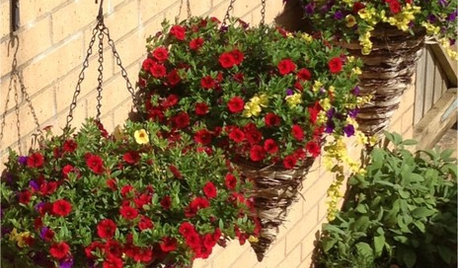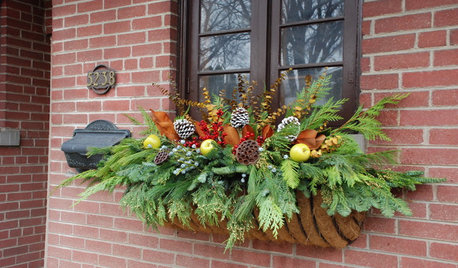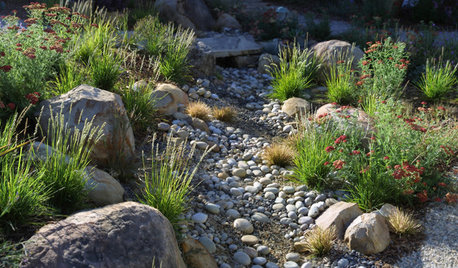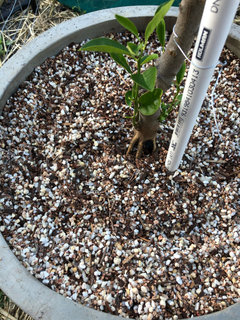CONTAINER SOILS - WATER MOVEMENT and RETENTION XXII
tapla (mid-Michigan, USDA z5b-6a)
9 years ago
last modified: 9 years ago
Featured Answer
Comments (1K)
tropicofcancer (6b SW-PA)
4 years agotapla (mid-Michigan, USDA z5b-6a) thanked tropicofcancer (6b SW-PA)Related Discussions
Container Soils - Water Movement & Retention XIV
Comments (164)Thanks for the kind words, B&C. In Mississippi, Memorial day would be a good target date for repotting the fig. Hibiscus need an annual repot. Do that toward the end of March, before it starts growing in earnest. Apple and most deciduous trees should be repotted just before or at the onset of spring budswell. Cactus - ask the cactus experts at the cacti/succulents forum. Desert rose - in Mississippi - June Umbrella plant - June There are ways to mechanically limit the amount of perched water a planting will hold, even if you're using a very water-retentive medium. Eliminating all or most of the perched water allows the grower to use media that would otherwise be or border on the edge of unusable. This outlines ways to cope with heavy (water-retentive) media Another effective way of dealing with media that hold too much water is through the use of ballast. You can read more about that technique here: Ballast ..... For now, checking your planting's moisture level regularly with a 'tell' will make a difference in your plant's appearance and level of vitality. Here's something I wrote about that: Over-watering saps vitality and is one of the most common plant assassins, so learning to avoid it is worth the small effort. Plants make and store their own energy source – photosynthate - (sugar/glucose). Functioning roots need energy to drive their metabolic processes, and in order to get it, they use oxygen to burn (oxidize) their food. From this, we can see that terrestrial plants need air (oxygen) in the soil to drive root function. Many off-the-shelf soils hold too much water and not enough air to support good root health, which is a prerequisite to a healthy plant. Watering in small sips leads to a build-up of dissolved solids (salts) in the soil, which limits a plant's ability to absorb water – so watering in sips simply moves us to the other horn of a dilemma. It creates another problem that requires resolution. Better, would be to simply adopt a soil that drains well enough to allow watering to beyond the saturation point, so we're flushing the soil of accumulating dissolved solids whenever we water; this, w/o the plant being forced to pay a tax in the form of reduced vitality, due to prolong periods of soil saturation. Sometimes, though, that's not a course we can immediately steer, which makes controlling how often we water a very important factor. In many cases, we can judge whether or not a planting needs watering by hefting the pot. This is especially true if the pot is made from light material, like plastic, but doesn't work (as) well when the pot is made from heavier material, like clay, or when the size/weight of the pot precludes grabbing it with one hand to judge its weight and gauge the need for water. Fingers stuck an inch or two into the soil work ok for shallow pots, but not for deep pots. Deep pots might have 3 or more inches of soil that feels totally dry, while the lower several inches of the soil is 100% saturated. Obviously, the lack of oxygen in the root zone situation can wreak havoc with root health and cause the loss of a very notable measure of your plant's potential. Inexpensive watering meters don't even measure moisture levels, they measure electrical conductivity. Clean the tip and insert it into a cup of distilled water and witness the fact it reads 'DRY'. One of the most reliable methods of checking a planting's need for water is using a 'tell'. You can use a bamboo skewer in a pinch, but a wooden dowel rod of about 5/16” (75-85mm) would work better. They usually come 48” (120cm) long and can usually be cut in half and serve as a pair. Sharpen all 4 ends in a pencil sharpener and slightly blunt the tip so it's about the diameter of the head on a straight pin. Push the wooden tell deep into the soil. Don't worry, it won't harm the root system. If the plant is quite root-bound, you might need to try several places until you find one where you can push it all the way to the pot's bottom. Leave it a few seconds, then withdraw it and inspect the tip for moisture. For most plantings, withhold water until the tell comes out dry or nearly so. If you see signs of wilting, adjust the interval between waterings so drought stress isn't a recurring issue. Al...See MoreContainer Soils - Water Movement and Retention XXI
Comments (57)Hi Robin!!! I'm still getting notifications on the threads that I post to. You can adjust your setting by going to " your Houzz" then ' edit profile' then hit ' advanced settings' that should help fix what you need as far as notifications. If you look at the bottom of this thread where you would comment, you will see in green letters " switch off notifications about new threads". If its already off you can click it back on. Always nice to see you!!! One of my Plumeria trees is blooming inside right now. It's supposed to be a dark pink, but its yellow. Go figure!! ;-) I agree about Al reposting if they can't get it fixed. I am sure he has it saved on his computer. ( I hope so) I just worry about all of the other threads, fertilizer, intro for beginners etc. so much information that needs to be fixed for the new people. We need this great information for us to share as well as for the new people searching for the great threads. Happy Valentine's Day, Robin , Al and everyone!! Laura...See MoreCorkscrew Willows with garden soil in planters
Comments (6)You may have lucked out with both your choice of trees and the misadvised soil :-) Willows will grow darn near anywhere and certainly do not mind heavy, waterlogged soil. Of any plants that might survive long term under those conditions, willows are definitely on the short list....See MoreSoil questions with pics
Comments (1)I'd recommend starting from scratch -- you're likely to get much, much better results with a high-quality container mix, and the original post in this thread will provide all the information that you need to assemble one: CONTAINER SOILS - WATER MOVEMENT and RETENTION XXII...See Moretapla (mid-Michigan, USDA z5b-6a)
4 years agotapla (mid-Michigan, USDA z5b-6a)
4 years agoGregório Miranda
4 years agolast modified: 4 years agotapla (mid-Michigan, USDA z5b-6a) thanked Gregório Mirandatropicofcancer (6b SW-PA)
4 years agotapla (mid-Michigan, USDA z5b-6a) thanked tropicofcancer (6b SW-PA)tropicofcancer (6b SW-PA)
4 years agotapla (mid-Michigan, USDA z5b-6a) thanked tropicofcancer (6b SW-PA)tapla (mid-Michigan, USDA z5b-6a)
4 years agoGregório Miranda
4 years agolast modified: 4 years agotapla (mid-Michigan, USDA z5b-6a) thanked Gregório Mirandatropicofcancer (6b SW-PA)
4 years agotapla (mid-Michigan, USDA z5b-6a) thanked tropicofcancer (6b SW-PA)Gregório Miranda
4 years agoJodiK
4 years agoGregório Miranda
4 years agolast modified: 4 years agoJust Started(Sydney)
4 years agoSergey Varlamov
4 years agotapla (mid-Michigan, USDA z5b-6a)
4 years agoJodiK
4 years agomblan13
4 years agotapla (mid-Michigan, USDA z5b-6a)
4 years agolast modified: 4 years agotropicofcancer (6b SW-PA)
4 years agotapla (mid-Michigan, USDA z5b-6a) thanked tropicofcancer (6b SW-PA)tapla (mid-Michigan, USDA z5b-6a)
4 years agotropicofcancer (6b SW-PA)
4 years agolast modified: 4 years agotapla (mid-Michigan, USDA z5b-6a) thanked tropicofcancer (6b SW-PA)tapla (mid-Michigan, USDA z5b-6a)
4 years agolast modified: 4 years agoDylan
4 years agotapla (mid-Michigan, USDA z5b-6a)
4 years agotropicofcancer (6b SW-PA)
4 years agotapla (mid-Michigan, USDA z5b-6a) thanked tropicofcancer (6b SW-PA)tapla (mid-Michigan, USDA z5b-6a)
4 years agoSergey Varlamov
4 years agoDylan
4 years agolast modified: 4 years agoDylan
4 years agotropicofcancer (6b SW-PA)
4 years agotropicofcancer (6b SW-PA)
4 years agotapla (mid-Michigan, USDA z5b-6a)
4 years agojbclem
4 years agolast modified: 4 years agoDylan
4 years agolast modified: 4 years agoWMS Lee
4 years agotapla (mid-Michigan, USDA z5b-6a)
4 years agotapla (mid-Michigan, USDA z5b-6a)
4 years agolast modified: 4 years ago
Related Stories

CONTAINER GARDENSContainer Gardening Basics: The Dirt on Soil
Learn the types of potting soil available and the best mixes to help your containers thrive
Full Story
GARDENING GUIDES10 Solutions for Soggy Soil
If a too-wet garden is raining on your parade, try these water-loving plants and other ideas for handling all of that H2O
Full Story
GARDENING GUIDESHow to Stop Worrying and Start Loving Clay Soil
Clay has many more benefits than you might imagine
Full Story
GARDENING GUIDESHow to Pick a Mulch — and Why Your Soil Wants It
There's more to topdressing than shredded wood. Learn about mulch types, costs and design considerations here
Full Story
GARDENING GUIDESGreat Design Plant: Anemone Canadensis Adds Pizzazz to Water’s Edges
Plant Canadian anemone along pond, lake or stream edges for a splash of white flowers in late spring
Full Story
CURB APPEALCrazy for Colorful Cones: 5 Container Plantings Beyond the Bowl
Give even a small garden an exuberant vibe with hanging cones overflowing with blooming beauties
Full Story
FARM YOUR YARDHow to Grow Vegetables in Containers
Get glorious vegetables and fruits on your patio with a pro’s guidance — including his personal recipe for potting mix
Full Story
GARDENING GUIDES10 Dazzling Winter Container Designs
Get inspired by these ideas for festive arrangements in outdoor pots and planters
Full Story
GARDENING GUIDESHow to Install a Drip Irrigation System
Save time and water with a drip watering system in your vegetable garden — a little patience now will pay off later
Full Story
LANDSCAPE DESIGNHow to Design Your Landscape to Slow Down Water
Putting the brakes on stormwater runoff is the first step in sustainable water design
Full StorySponsored
Your Custom Bath Designers & Remodelers in Columbus I 10X Best Houzz











Bill